MQTT Transmission provides a configuration section to the Ignition Gateway. These can be seen in the Configure section of the Ignition Gateway web UI in the left-hand navigation pane - Configure → MQTT Transmission. There are two configuration pages "History" and "Settings".
Settings
Once in the "Settings" configuration section there are five tabs: General, Servers, Sets, Transmitters, and Records. Each of these tabs is described in detail in the following sections.
General
The General Settings tab contains advanced configuration options for the default MQTT Server settings created in the Servers tab. These are described below.
- Enabled
- Whether or not to enable or disable MQTT Transmission from connecting to the configured MQTT Servers.
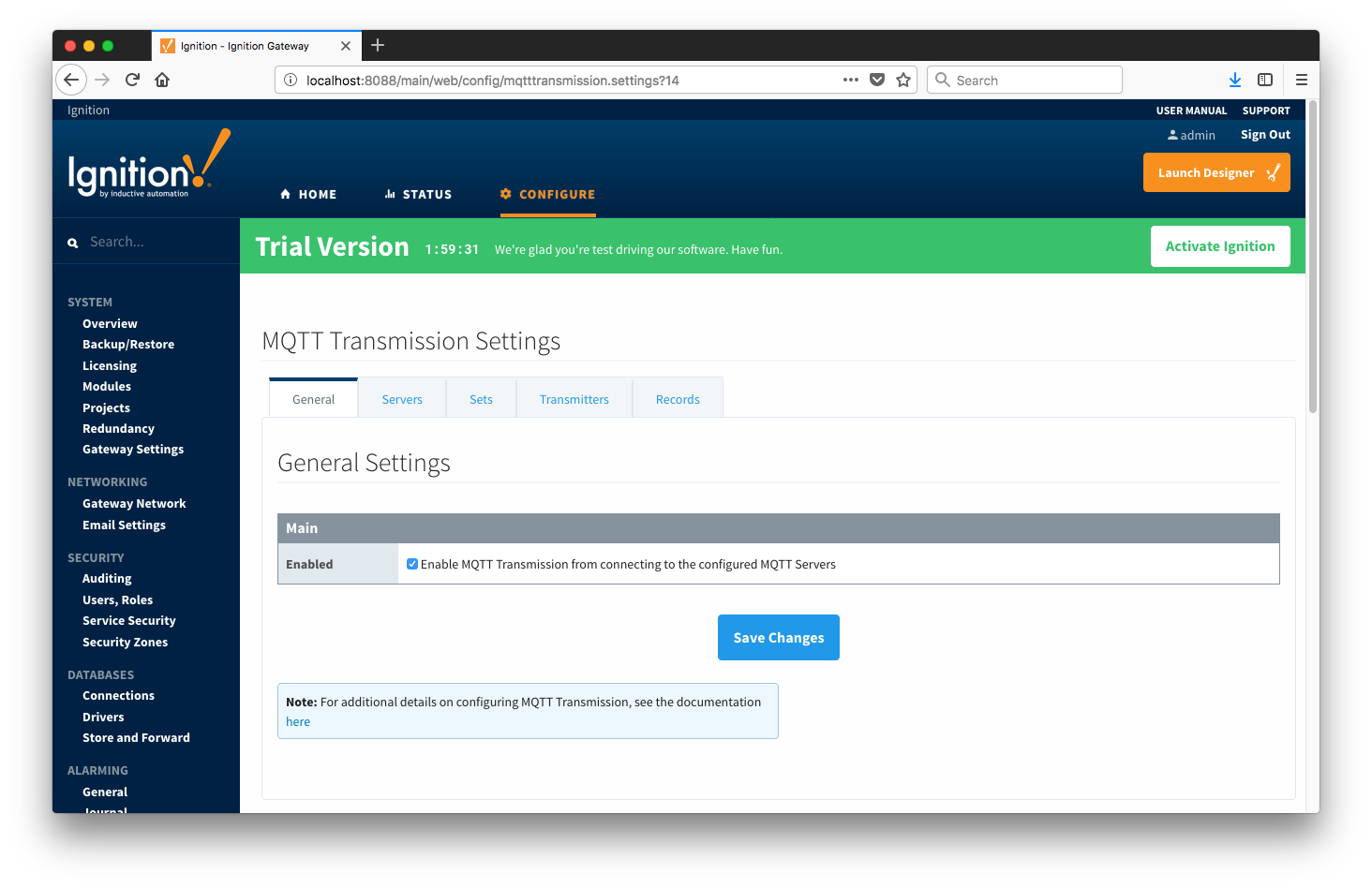
Servers
The first tab is a list of MQTT Servers that MQTT Transmission should connect to. By default, MQTT Transmission is configured to connect to a local MQTT Distributor based MQTT Server. It is set up to connect to localhost, port 1883, using the default username/password pair of admin/changeme. Out of the box MQTT Transmission will work with MQTT Distributor and its default configuration.
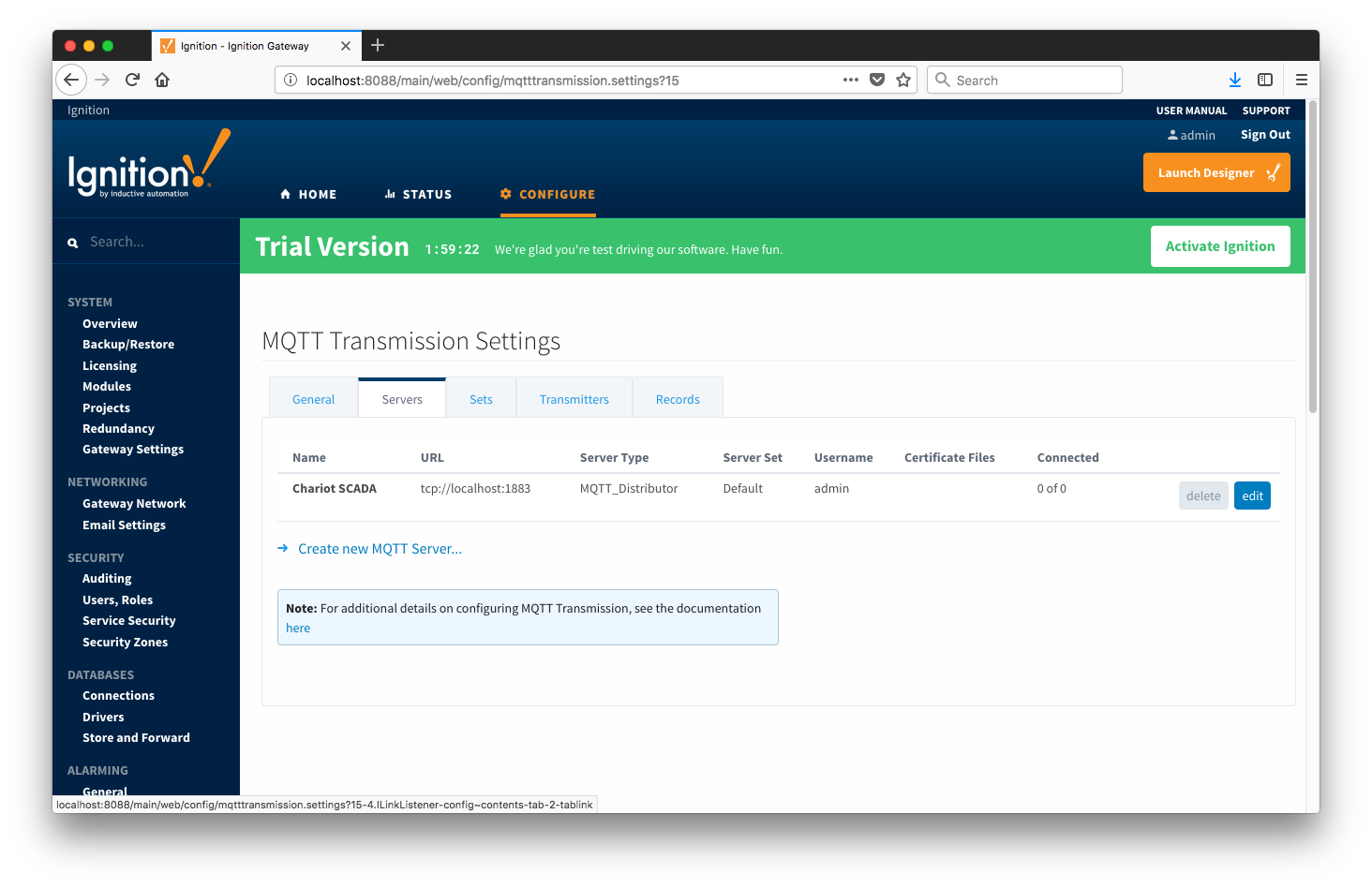
Additional or alternative MQTT Servers can be configured in MQTT Transmission. Often times more than one will be configured to handle fail-over or in redundant or geographically distributed systems. The configuration options for servers are listed below.
Main Properties
- Name
- This is the friendly name of the MQTT Server used to easily identify it
- URL
- This is the URL of the MQTT server. Its format is as follows: [protocol]://[location]:[port]. Each of these are shown below
- protocol - Either tcp or ssl
- location - The server location. e.g. localhost, myserver.chariot.io, mydomain.com, etc
- port - The port the MQTT Server is listening on. Generally this is 1883 if using TCP or 8883 if using SSL
- Server Type
- This is the type of MQTT Server to connect to
- Chariot - If connecting to a Cirrus Link Chariot on-premise or Chariot cloud based MQTT Server
- MQTT_Distributor - If connecting to a Ignition MQTT Distributor server
- Third_Party - If connecting to a third party 3.1.1 compliant MQTT Server
- AWS_Greengrass - If connectiong to an AWS Greengrass Server.
- Note: This server type should not be used whe using MQTT Transmission in conjunction with MQTT Engine.
- Server Set
- The Set that this server is a member of.
- Username
- The MQTT username to use in the MQTT connect packet. This is required if the MQTT Server to connect to requires it.
- Password
- The MQTT password to use in the MQTT connect packet. This is required if the MQTT Server to connect to requires it.
TLS Properties
Advanced Properties
- Client ID
- Optional MQTT client ID to use. If left blank, a random client ID will be create of the form 'MT-xxxxxxxx-xxxx-xxxx'. This should almost always be left blank. Do not use this setting unless it is an absolute required that a specific client ID be used for connection to the MQTT server.
- Keep Alive
- The MQTT client keep alive time (in seconds).
- Random Startup Delay
- The Random Startup Delay in milliseconds of the form 'min-max' where min is the low end and max is the high end of the random range. This will provide a random delay in the startup and connection of the MQTT Client with the MQTT Server. This is useful in use cases where large numbers of clients might be reconnecting simultaneously to the MQTT Server. By introducing a randomized delay, the rate at which clients will connect will be spread out over a period of time, reducing the load on the server.
Clicking on the 'Create new MQTT Server...' link will bring up the following form to add a new Server.

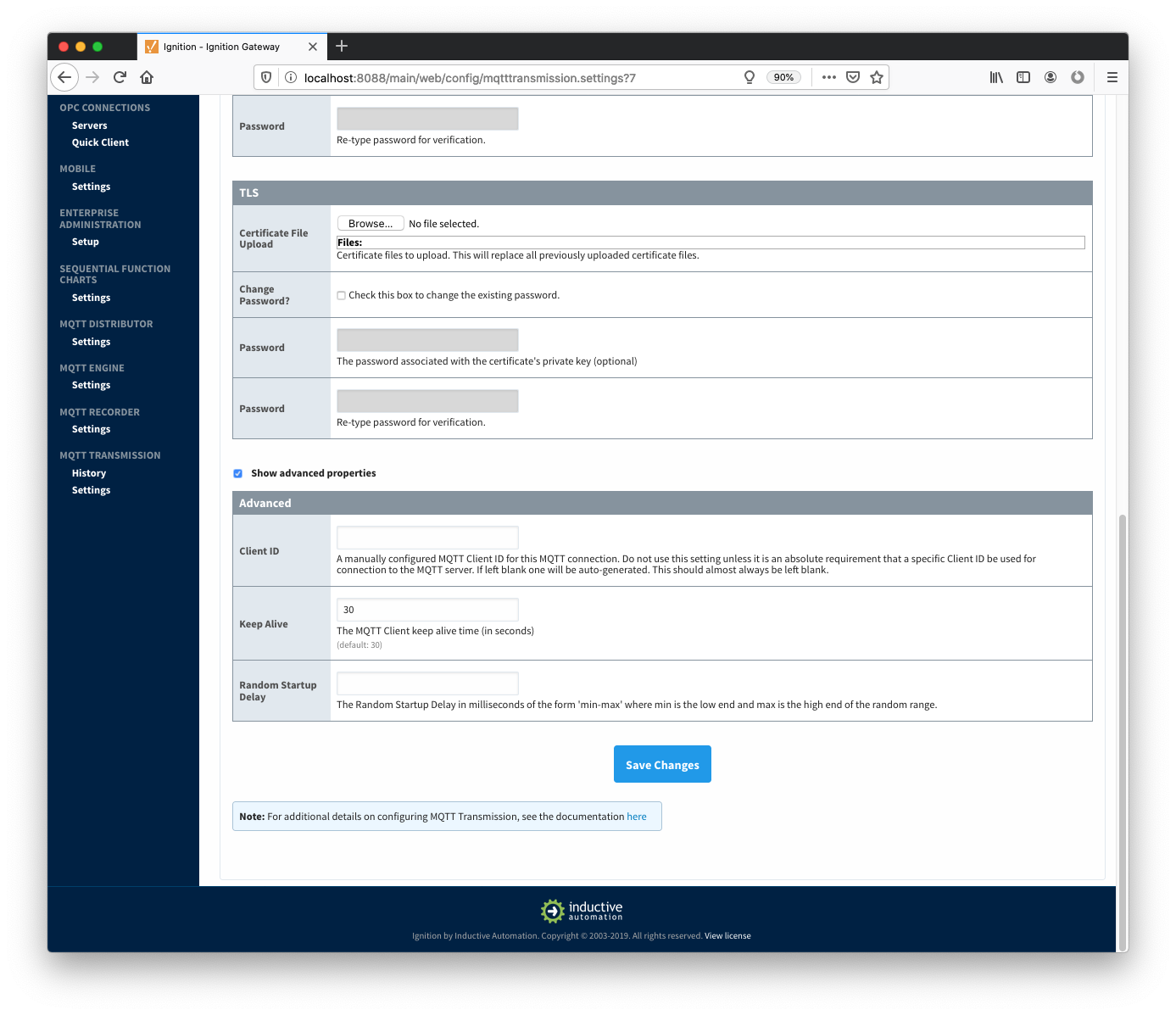
Sets
The Sets tab contains a list of server sets. Each set represents a logical grouping of MQTT servers. When a set is referenced by a Transmitter configuration a single connection to one of the servers in the set will be maintained. The other servers will act as failover in the case that a connection with the first is lost. Server sets are disjoint, meaning that a single MQTT server cannot be in more than one set.
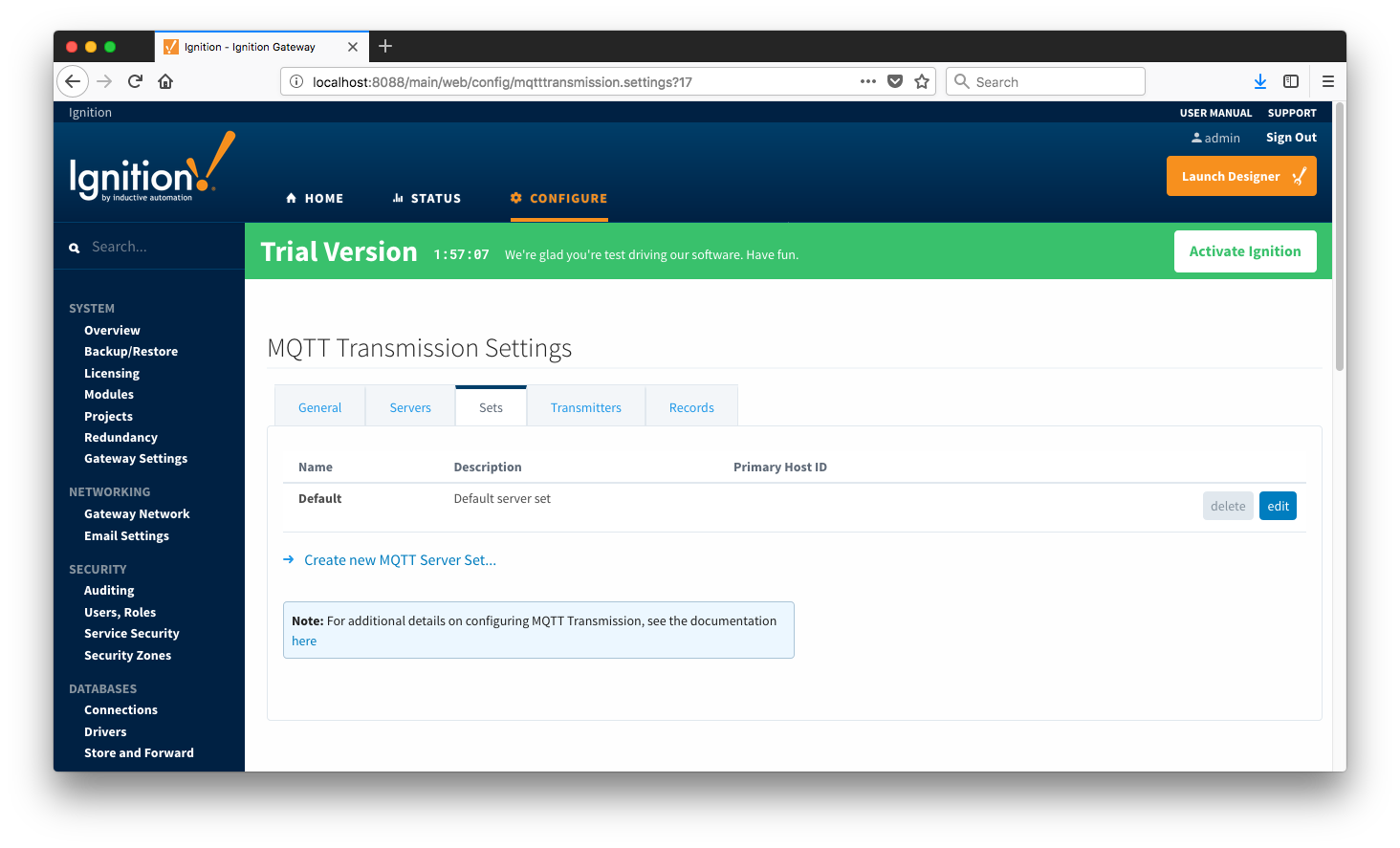
Additional sets can be configured in MQTT Transmission for situations where multiple Transmitters need to point to different sets (or groupings) of MQTT servers. The configuration options for sets are listed below.
- Name
- This is the friendly name of the set used to easily identify it.
- Description
- This is a friendly description of the set.
- Primary Host ID
- The primary host ID to use for 'state' notifications. These notifications are used to notify MQTT Transmission if the primary backend application loses connection with the MQTT Server, meaning it has gone 'offline'. If MQTT Transmission is notified that the primary backend application has gone 'offline', it will close it's client connection with the MQTT server and walk to the next MQTT server defined in the set. If the primary host ID is not set, MQTT Transmission will not subscribe on the notification topics and not receive any 'state' notifications.
- This must contain only letters, numbers, and the following special characters: . $ % @ ! - _ ^ *

Transmitters
Transmitters are the agents within MQTT Transmission that monitor tags, convert them to Sparkplug Messages, and publish them to an MQTT Server. Each transmitter is configured with a server Set and will attempt to maintain an MQTT client connection with one server in that Set at all times.
There are two types of Transmitters: Default and Custom. These types are explained in more detail below.
Default Transmitter
MQTT Transmission provides a single Default Transmitter. The Tags that this Transmitter monitors must be placed in the "Edge Nodes" folder within the configured Tag Provider. Their Tag paths must conform to the strict structure of:
<Provider>/Edge Nodes/<GroupID>/<EdgeNodeID>/<DeviceID
The individual elements of the above tag path (Group ID, Edge Node ID, and Device ID) are used when building up the MQTT message payload that will represent the Tags.
The configuration options for the Default Transmitter are listed below.:
- Name
- Enabled
- Whether the Default Transmitter is enabled
- Tag Provider Name
- The name of the tag provider that Transmission will monitor. By default this is the Ignition 'default' provider.
- Tag Pacing Period
- The buffer period for outgoing Transmission messages in milliseconds. The default is 1000ms. This means when a tag change event is detected 1000ms will elapse before an MQTT message is sent. This allows additional tag change events to be buffered and put into the message and in turn reduce the number of generated MQTT messages.
- Set
- The Set that the default MQTT Transmission client will connect to.
- Discovery Delay
- An optional startup delay, in milliseconds, to wait before scanning for Tags to monitor. This is useful when Tags are dynamically created on initial startup, as is the case when using the MQTT Engine module.
- History Store
- The MQTT Transmission History Store to use with the Default Transmitter.
- In-Order History
- Whether MQTT Transmission will publish historical messages in-order upon reconnecting to an MQTT Server before resuming the publishing of live events.
- Aliased Tags
- Whether to use aliases for tag names when published data messages as tag values change. This is used to optimize payload size when publishing data.
- Compression
- The algorithm to use to compress payloads before they are published to the MQTT Server. If 'NONE' is selected then compression is disabled.
- Block Commands
- Whether to block commands and tag writes received as messages from the MQTT server.
- Convert UDTs
- Whether to convert UDT members to normal Tags before publishing. If enabled the Tags representing the UDT member will retain their member path prefixed by the UDT Instance name.
- Publish UDT Definitions
- Whether to publish UDT definitions in the birth messages that are publish upon every connection or reconnection with an MQTT server.
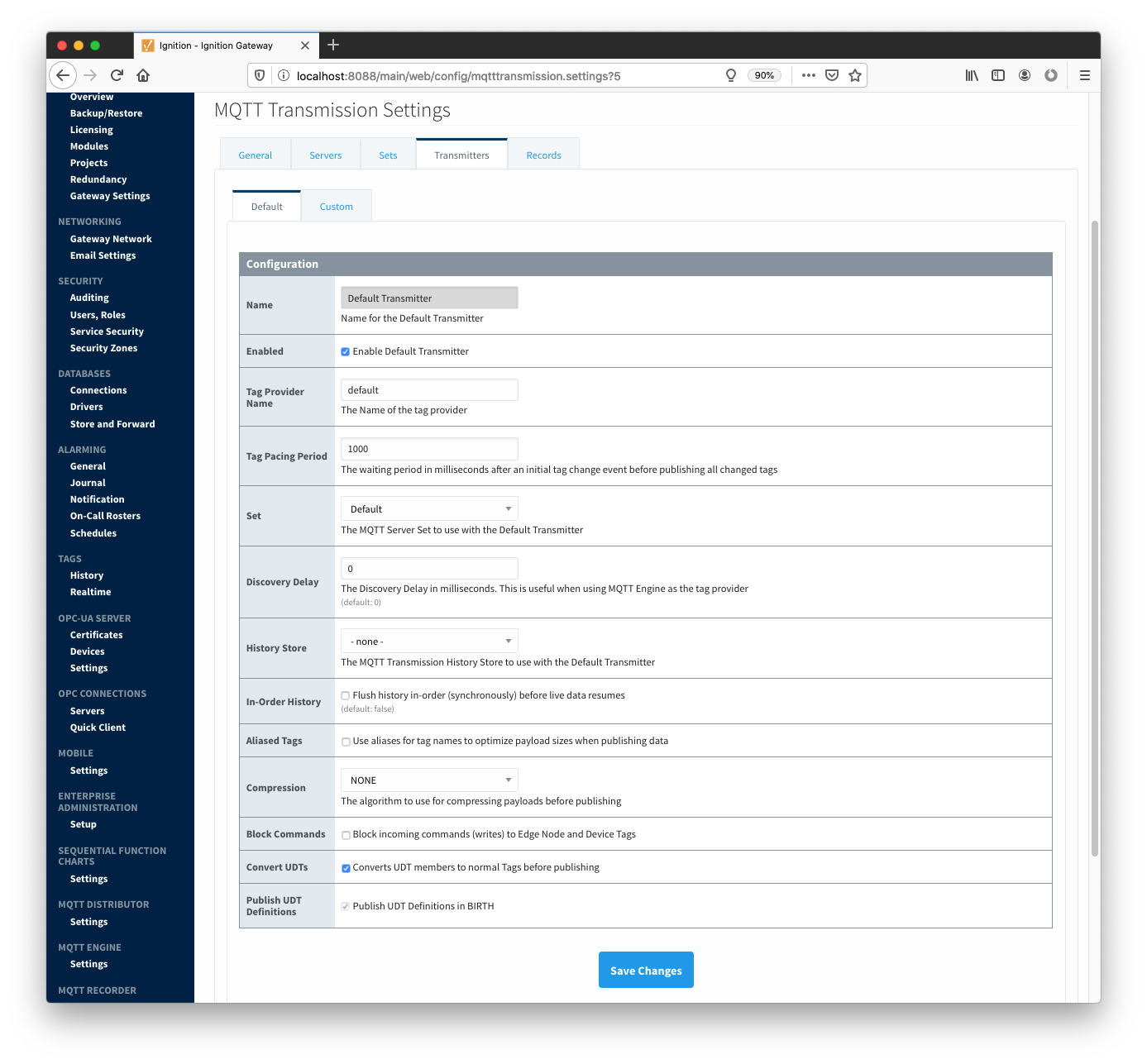
Custom Transmitters
Custom Transmitters behave in much the same way as the Default Transmitter. However, unlike the Default Transmitter, Custom Transmitters are not bound to a specific "Edge Nodes" folder and do not have any required folder path structure. The Group ID, Edge Node ID and Device ID are explicitly defined in a Custom Transmitter configuration instead of inferred from the tag path, as in the Default Transmitter. This allows Custom Transmitters to point at any folder in any provider and monitor the contained tags and/or tag folders.
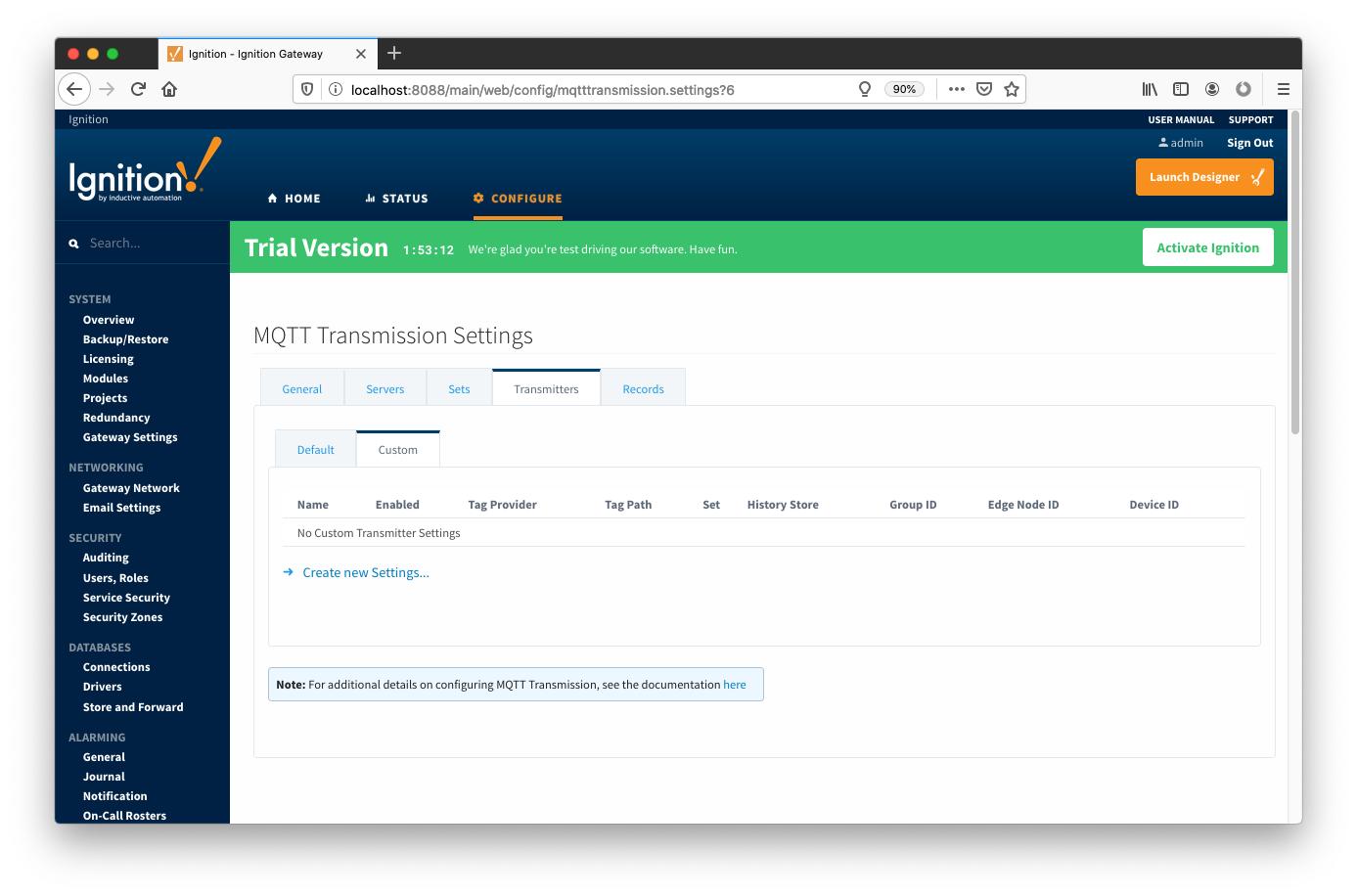
Each Custom Setting has the following fields
- Name
- The name of the Custom Transmitter Setting.
- Enabled
- Whether the Default Transmitter is enabled
- Tag Provider Name
- The name of the tag provider that Transmission will monitor.
- Tag Path
- An optional folder path under the tag provider where the root folder of the tags can be found.
- Tag Pacing Period
- The buffer period for outgoing Transmission messages in milliseconds.
- Set
- The Set that the Custom Settings client will connect to.
- Discovery Delay
- An optional startup delay, in milliseconds, to wait before scanning for Tags to monitor. This is useful when Tags are dynamically created on initial startup, as is the case when using the MQTT Engine module.
- History Store
- The MQTT Transmission History Store to use with the Default Transmitter.
- In-Order History
- Whether MQTT Transmission will publish historical messages in-order upon reconnecting to an MQTT Server before resuming the publishing of live events
- Aliased Tags
- Whether to use aliases for tag names when published data messages as tag values change. This is used to optimize payload size when publishing data.
- Compression
- The algorithm to use to compress payloads before they are published to the MQTT Server. If 'NONE' is selected then compression is disabled.
- Block Commands
- Whether to block commands and tag writes received as messages from the MQTT server.
- Convert UDTs
- Whether to convert UDT members to normal Tags before publishing. If enabled the Tags representing the UDT member will retain their member path prefixed by the UDT Instance name.
- Publish UDT Definitions
- Whether to publish UDT definitions in the birth messages that are publish upon every connection or reconnection with an MQTT server.
Sparkplug Settings
- Group ID
- An ID representing a logical grouping of MQTT Edge Of Network (EoN) Nodes and Devices into the infrastructure.
- Edge Node ID
- An ID that uniquely identifies the MQTT Edge Of Network (EoN) Node within the infrastructure.
- Device ID
- An optional ID that uniquely identifies a Device within the infrastructure.
Note that if a 'Device ID' is not specified, any folder within the folder specified by the Tag Path will be considered a device folder and any Tags within it will be published as device Tags.
Clicking on the 'Create new Custom Settings..' link will bring up the following form to add a new Server.
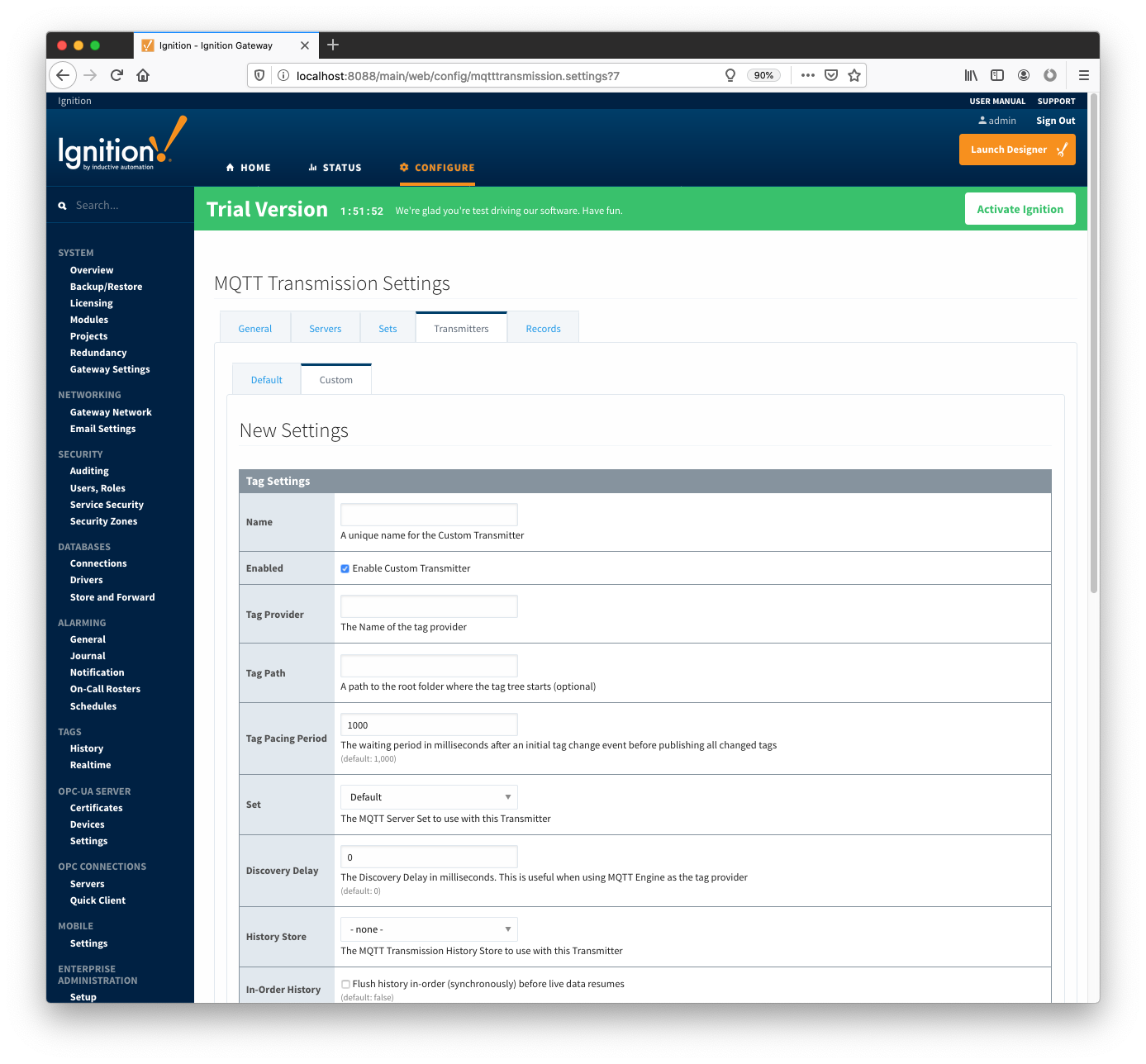
Records
The 'Records' tab allows user to create a table of custom records. Each record defines a folder (under specified tag provider) in which user can create a number of tags that will be published as a record by clicking the 'Publish' checkbox. The 'Publish' tag will be created automatically in the folder specified.
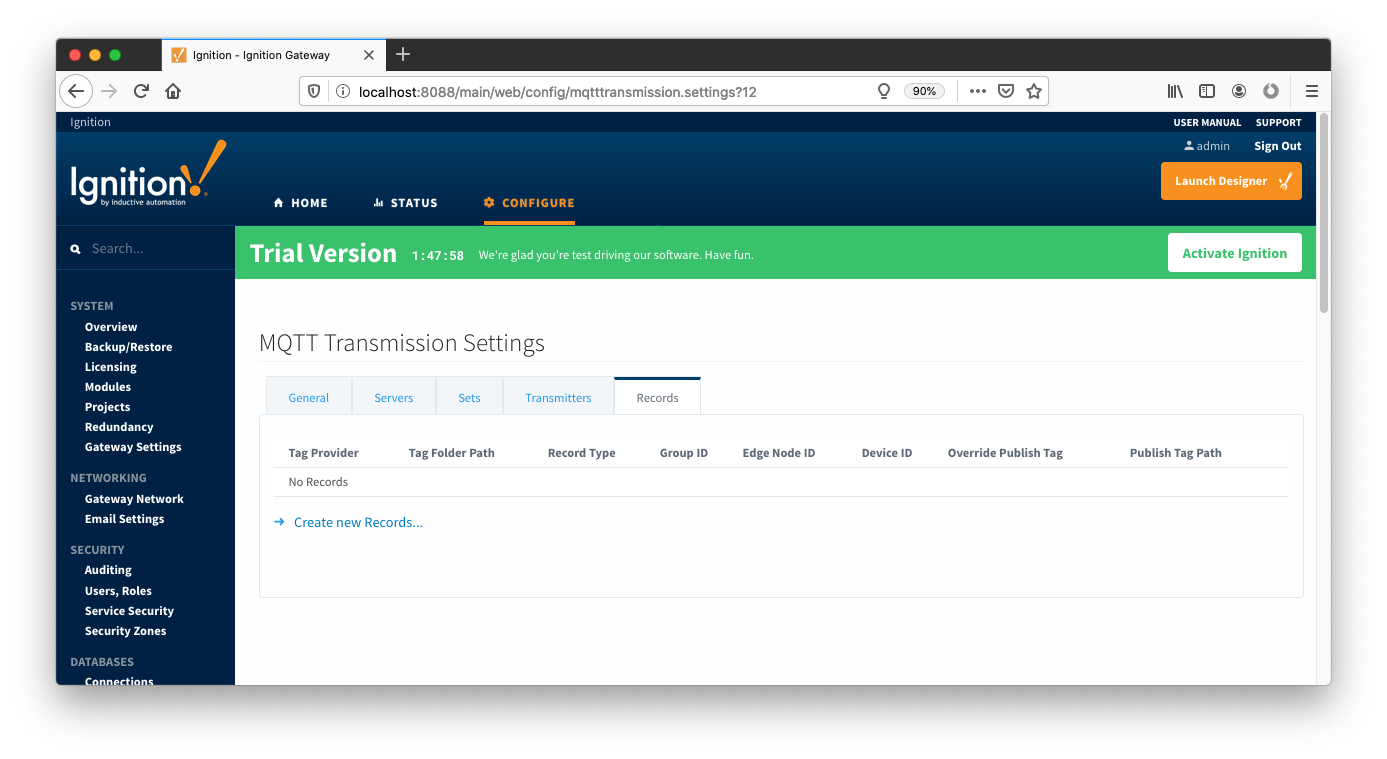
Clicking on the 'Create new Records ...' link will bring up the following form to add a new Record:
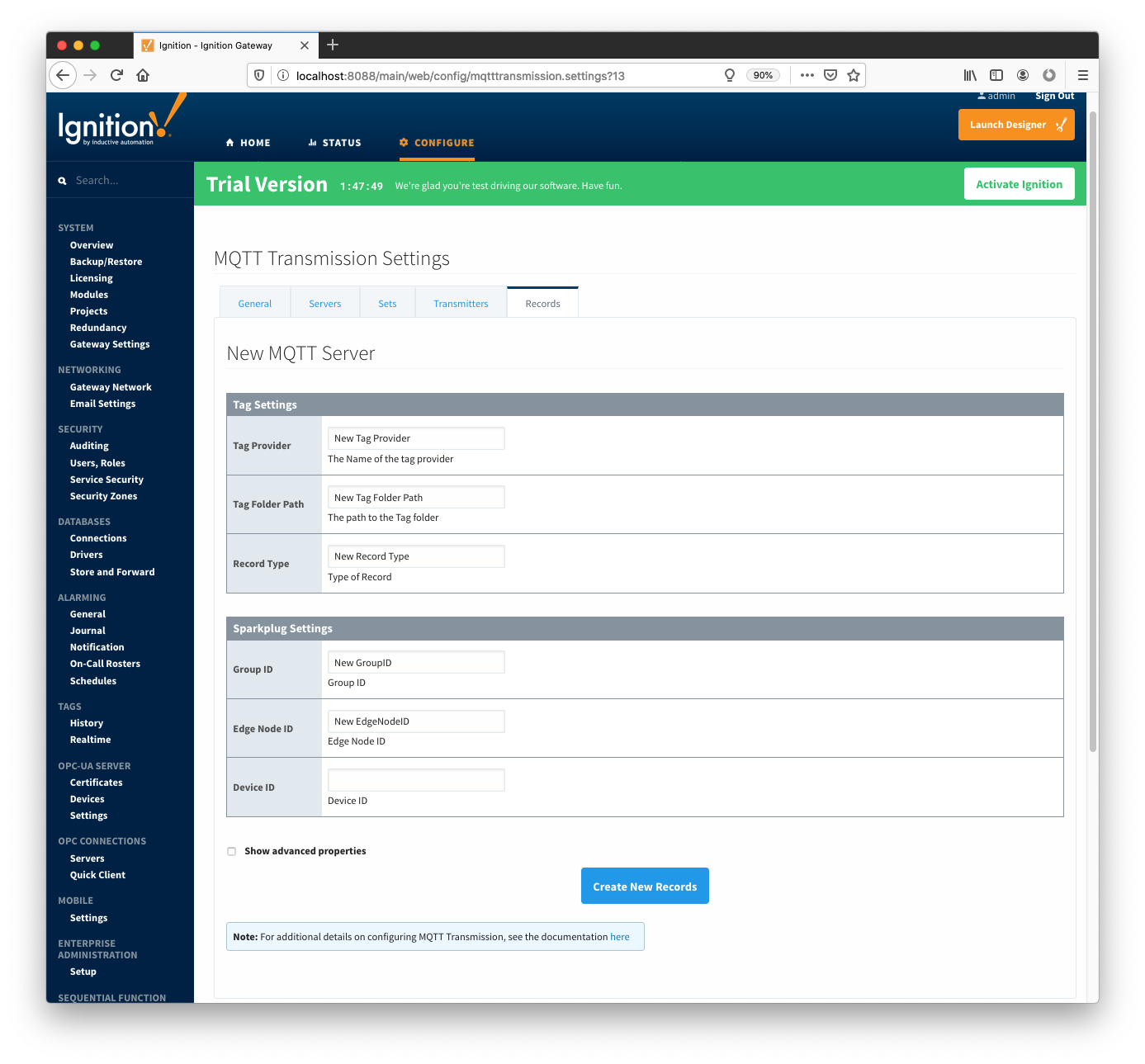 Each custom record has the following fields under two categories: 'Tag Settings', and 'Sparkplug Settings'
Each custom record has the following fields under two categories: 'Tag Settings', and 'Sparkplug Settings'
- Tag Provider
- The name of the tag provider (i.e. default)
- Tag Folder Path
- The path to the tag folder under specified tag provider
- Record Type
- Type of Record. This can be any label or identifier.
Sparkplug Settings
- Group ID
- An ID representing a logical grouping of MQTT Edge Of Network (EoN) Nodes and Devices into the infrastructure.
- Edge Node ID
- An ID that uniquely identifies the MQTT Edge Of Network (EoN) Node within the infrastructure.
- Device ID
- An optional ID that uniquely identifies a Device within the infrastructure.
History
The "History" page allows for the configuration of MQTT Transmission History Stores. In the event that a Transmitter loses it's connection with the MQTT Server and is unable to reconnect, a History Store (if enabled) will store all messages corresponding to change events on the monitored tags. Once a connection with an MQTT server is reestablished the History Store will publish the stored messages with a flag set to indicate that the messages are "historical" to prevent confusion with live data values.
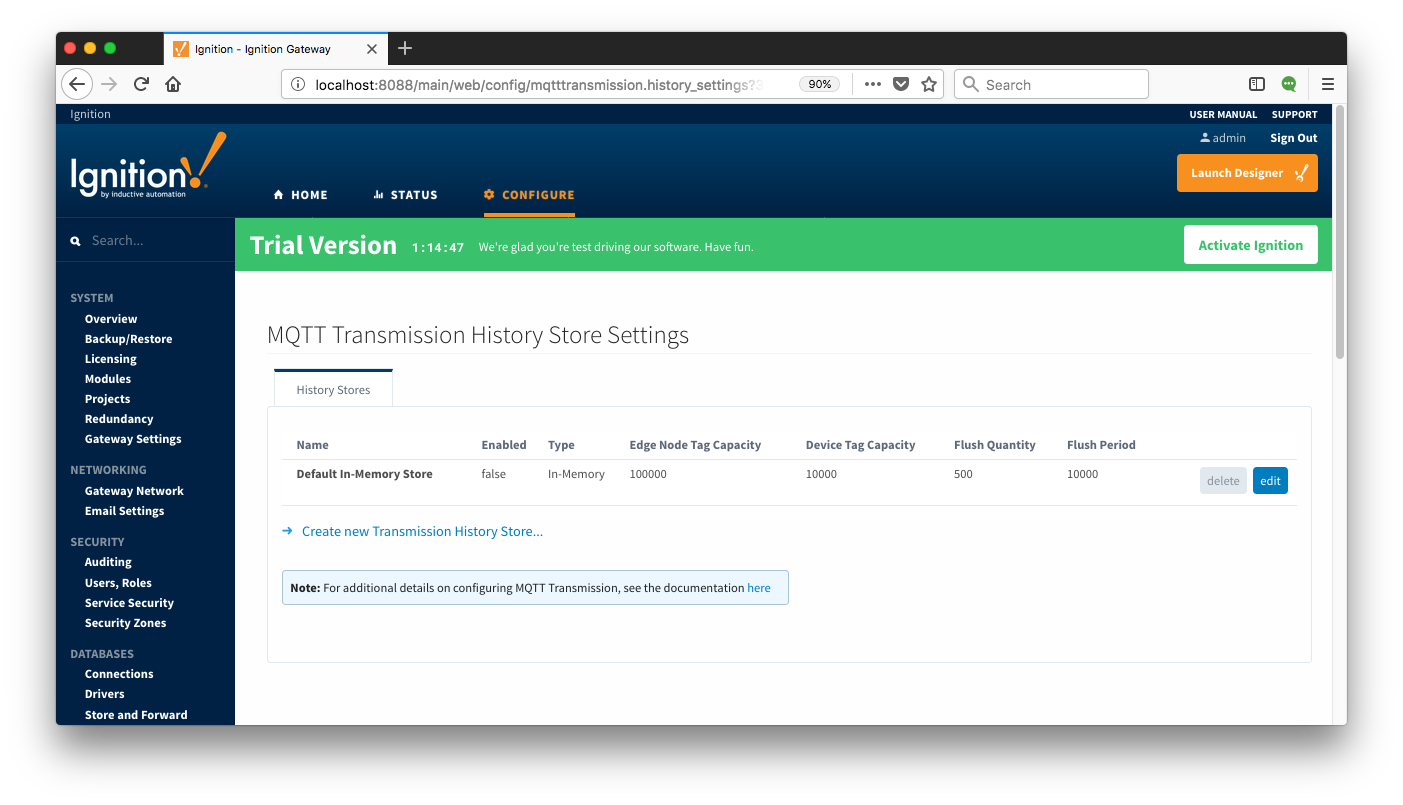 Each History Store has the following fields
Each History Store has the following fields
- Name
- The name of the History Store.
- Enabled
- Whether the History Store is enabled.
- Type
- The type of History Store.
- Edge Node Tag Capacity
- The maximum number of edge node tags to store (per edge node) before dropping the oldest currently stored tag value.
- Device Tag Capacity
- The maximum number of device tags to store (per device) before dropping the oldest currently stored tag value.
- Flush Quantity
- The maximum number of tags tags to publish in a single message upon reestablishing communication.
- Flush Period
- The period to wait in milliseconds between publishes when flushing messages upon reestablishing communication.

![]()
![]()
![]()
![]()
![]()
![]()
![]()
![]()
![]()
![]()












